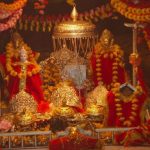Ribba Village, is a beautiful and peaceful village situated at an altitude of approximately 3,745 metres above sea level in the Pooh tehsil in the Kinnaur district of Himachal Pradesh.Famous for its pine-nut forests, grape vineyards and unique local culture.
About Ribba Village
Ribba (locally called Rirang “Ri” = pine nut, Rang=peak) -It covered by trees of conifer Chilgoza and its surrounding villages are Rispa and Purbani. It is located on the northern edge of the Kinner Kaillash massif, providing views of dramatic Himalayan landscapes.
Geography, Culture & People

Ribba is at great altitude, thus vegetation hardly exists over a few tens of kilometres or so, most common being pine and juniper, rhododendron, fir etc. Further down, fruit orchards grow apples, grapes, apricots and walnuts. While the locals predominantly Scheduled Tribe communities continue to adhere to traditional Kinnauri ways, fusing Hindu and Buddhist practices around Kasuraj Ji temple that is presided over by both Hindu deities and Buddhist spirits.
History of Ribba Village

For as poorly documented as Ribba seems to be, this project of its namesake should claim more than mention: the name of course reflects its Northern Lake Tazakka pine nut ancestry. History here is as rich, with the ancient Kasuraj Ji Temple along with a Buddhist monastery in the vicinity which are telling examples of the local syncretic spiritual tradition.
Ribba Highlights
- It was all natural with snow clad peaks and pine groves.
- Chilgoza pines with pine nuts Kietzerk Valley fruit orchards.
- Indigenous Rokh Dakhan grape, vineyards & the famous local Angoori wine.
Ribba Village Overview

- Altitude: 3,745 m
- Distance from Reckong Peo: .33 km east
- Access: via NH‑5 and Branch Road from Puh/Karchham
- Surroundings: Rispa, Purbani, Kinner Kailash ridge
- Economy: Chilgoza, Seb, Drakshan, Angoori wine non dino-goon festivals
Local festivals
- Bish, Phulaich (traditional Kinnaur celebrations)
How to Reach Ribba?

- By Air: The nearest airport is Bhuntar Airport (Kullu)
- By Rail: Nearest railhead is Shimla Railway Station
- By Road: Drive NH-5 through Reckong Peo → Puh → off‑branch to Ribba (~33 km off main route)
- Public transport: Shared cabs / buses from Kalpa or Reckong Peo
When is the Best Time to Visit Ribba Village?
- Spring (March–April): Blooming Orchards, Cool Weather
- Fall (October-November): No clouds, colorful scenery.
- Monsoon (July to September): Chance of landslides; not recommended for travel.
- Winter (December-May): A blanket of heavy snow can encase the village as access to trekking routes are cut off.
Ribba Weather (Local Conditions)
Highs up to around 16–18°C and lows down to 11–13°C in winter, They have snow landslides on the winter side zero nights or waste of money and God forbid. Slippery roads on account of monsoon downpours, as well as landslides. Check the latest weather and road conditions before you travel.
Things to Do in Ribba

- Try local vitamins-grape wine (Angoori) locally distilled and made from basket pressed Rokh Dakhan grapes at village homes.
- Visit Kasuraj Ji Temple & Buddhist shrine around it.
- Mélange of grapevine, apple and apricot trees on foot.
- You can collect chilgoza nuts from pine forests.
- Wine‑making Discussions with the Locals.
- Witness the starlit Himalayan sky
Where to Stay
Ribba has no hotels; you can definitely stay with some homestays or guesthouses in Reckong Peo (about 33kms) or Kalpa (about 30kms). In peak season you will need to book in advance. Kalpa offers a sustainable and cultural experience accommodation option.
Distance from Major Cities

- Chandigarh: 460 km
- Delhi: 580 km
- Shimla: 268 km
- Mandi: 390 km
- Hamirpur: 450 km
- Manali: 330 kms
Helpful Travel Tips
- Acclimatize slowly and avoid altitude sickness.
- Wind and water-resistant warm layer.
- Travel during daytime as roads situated amidst mountains are narrow and have twists and turns.
- Ask the villagers or temples for permission to photograph.
- Carry Cash as ATMS are limited in this region.
- Carry a mini medical/first-aid kit in case of an emergency.
Conclusion
Quaint and peaceful, Ribba Village is not just a picturesque spot but a cultural treasure neatly tucked away in the Kinnauri heartland. Be it relishing the taste of homemade Angoori wine, hiking through dense pine forests taking a moment to enjoy life away from fast-moving scenes, or simply in for all those who seek peace in the mountains.
Ribba is an experience that will stay etched into your mind even after leaving this part of Himachal.
Go ahead and plan your visit to one of the best kept secrets in Himachal.
FAQs
Q1. Is There Any Entry Fee to Ribba Village?
Ans. No, they are all free to the public but Ribba is a village. But you may need local assistance in order to visit temples.
Q2. Can tourists buy Angoori wine?
Ans. True, though it is only craft beer produced locally and not sold in shops. It can also be purchased by the villagers themselves.
Q3. How Good For A Solo Traveller Is Ribba?
Ans. Yes, it’s generally safe. Check for road closures and weather conditions before traveling, however.
Q4. Ribba Village Weather Flat Archives
Ans. Ribba: Mild (max 18°C in summer) cool summers and most often cold (below zero) winters. Carry appropriate clothing.
Q5. Are there ATMs in Ribba?
Ans. No ATMs in the village. The nearest ATM is present in Reckong Peo.








